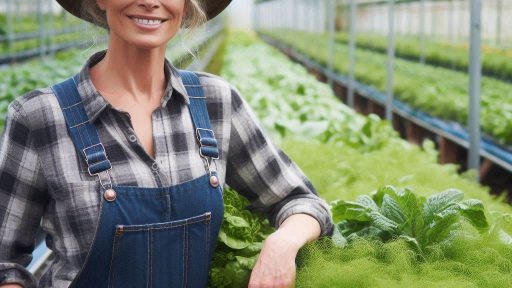Introduction
Tomato harvesting is crucial for ensuring quality and maximizing the yield of tomatoes.
Tomato harvesting is crucial for maintaining quality as it impacts taste, texture, and nutritional value.
Harvesting at optimal ripeness ensures peak flavor and nutritional content, preventing overripening or under ripening which can diminish taste and nutritional value.
Proper timing prevents damage during transport, reducing spoilage and ensuring freshness for consumers. Timely harvesting also preserves color and firmness, enhancing visual appeal and marketability.
Additionally, it maintains consistent quality for processing into various products like sauces and soups.
Overall, precise harvesting practices are essential for maximizing tomato quality, satisfying consumer preferences, and sustaining market demand.
This blog post will provide an overview of various techniques that can be utilized for effective tomato harvesting.
Following proper tomato harvesting techniques is essential to prevent damage and enhance the flavor, color, and texture of tomatoes.
Choosing the Right Time for Harvesting
Determining tomato maturity
- Look for external characteristics to determine tomato maturity.
- Test the internal ripeness of tomatoes to ensure they are ready for harvest.
Factors to consider when deciding the harvest time
- Follow variety-specific recommendations to determine the best time for harvesting tomatoes.
- Consider weather conditions, such as temperature and rainfall, which can affect tomato maturity.
- Take into account market demand, as harvesting at the right time can ensure better sales.
Role of maturity in achieving quality produce
Choosing the right time to harvest tomatoes is crucial in producing high-quality produce.
The factors mentioned above contribute to achieving optimal flavor and texture, maximizing market value and customer satisfaction.
Harvesting Tools and Equipment
Choosing the right tools for tomato harvesting is crucial to ensure a successful and high-quality yield. Here are some recommendations for selecting the appropriate tools.
Recommendations for choosing the right tools
- Pruning shears or scissors: Select a pair with sharp blades and ergonomic handles for easy and precise cutting.
- Harvesting containers: Opt for containers that are spacious, lightweight, and have sufficient ventilation to keep the tomatoes fresh.
Once you have chosen the appropriate tools, it is vital to maintain them properly to maximize their lifespan and functionality.
Proper maintenance and cleaning of tools
Regularly inspect your tools for any signs of wear and tear, such as dull blades or loose handles. Perform the following maintenance tasks:
- Sharpen the blades of your pruning shears or scissors using a sharpening stone or file.
- Oil any moving parts to ensure smooth operation and prevent rusting.
- Check the tightness of handles and screws, tightening as needed to prevent accidents.
Furthermore, proper cleaning of your tools after each use is essential to prevent the spread of diseases and maintain their effectiveness.
Importance of using sharp and clean tools for quality harvesting
Using sharp and clean tools for tomato harvesting is crucial for several reasons:
Transform Your Agribusiness
Unlock your farm's potential with expert advice tailored to your needs. Get actionable steps that drive real results.
Get Started- Sharp tools create clean cuts that minimize damage to the plant, reducing the risk of infections and promoting faster healing.
- Clean tools prevent the transmission of diseases between plants, ensuring a healthy crop.
- Well-maintained tools reduce stress on the plants, promoting better growth and increasing overall yield.
- Efficient tools save time and effort, allowing for quicker and more productive harvesting sessions.
By choosing the right tools, maintaining them properly, and using sharp and clean equipment, you can optimize your tomato harvesting process and achieve a high-quality yield.
Remember, investing in quality tools is worthwhile for long-term success in tomato cultivation.
Read: Organic Pest Control: Effective and Safe
Harvesting Techniques
Proper handling of tomatoes during harvesting
- Correct grip and pressure to avoid bruising.
- Handling fragile or delicate tomatoes.
- Avoiding excessive handling.
Correct stem removal technique
Methods for removing the stem without damaging the fruit.
Correct stem removal techniques for harvesting fruits involve using sharp, clean tools such as pruning shears or scissors.
Cut the stem close to the fruit, leaving a short stub to avoid damaging the fruit.
For delicate fruits like berries, pinch the stem gently between fingers and twist to detach.
Avoid tearing or bruising the fruit during removal.
In cases where the stem is tough or stubborn, gently wiggle it back and forth while applying slight pressure until it detaches.
Careful handling ensures minimal damage to the fruit, preserving its quality and shelf life.
Potential risks of improper stem removal.
Correct stem removal technique involves cutting stems at a 45-degree angle just above a leaf node or bud, using clean, sharp pruning shears.
This promotes healthy growth and prevents damage to the plant.
Improper removal, such as tearing or cutting too close to the main stem, can introduce pathogens, inhibit growth, and cause stress to the plant.
It may also lead to disease transmission between plants.
Additionally, rough handling during stem removal can bruise or damage the plant, reducing its overall health and yield potential.
Proper technique minimizes these risks, ensuring optimal harvest quality and plant vitality.
Strategies for efficient picking and sorting
Organizing the harvesting process.
Harvesting techniques aim for efficient picking and sorting while organizing the process seamlessly.
Strategies include timing harvests for optimal crop ripeness, employing mechanized tools like combine harvesters for large-scale operations, and handpicking for delicate fruits or vegetables.
Sorting methods involve manual or automated systems to separate produce based on size, ripeness, or quality standards.
Organizing the harvesting process encompasses planning fields for easy access, coordinating labor efficiently, and implementing proper storage facilities.
Utilizing technology such as GPS tracking can aid in precision harvesting, reducing waste and maximizing yield.
Overall, integrating these strategies ensures a streamlined and productive harvest.
Tips for preserving quality during sorting.
Harvesting techniques aim for efficiency and quality. Selective picking, focusing on ripe produce, maximizes yield and reduces waste.
Sorting strategies involve careful inspection for size, color, and defects.
Utilizing technology like sorting machines enhances accuracy and speed.
Showcase Your Farming Business
Publish your professional farming services profile on our blog for a one-time fee of $200 and reach a dedicated audience of farmers and agribusiness owners.
Publish Your ProfilePreservation of quality during sorting involves gentle handling to prevent bruising or damage. Implementing hygiene measures prevents contamination.
Proper storage conditions, like temperature and humidity control, maintain freshness.
Regular monitoring of produce post-sorting ensures quality retention.
Collaborating with experienced laborers and utilizing advanced equipment optimizes the harvesting and sorting process, ensuring high-quality yields.
Read: Vegetable Harvest Hints for Gardeners

See Related Content: Tech Tools Transforming Modern Crop Cultivation
Discover More: Top Weed Prevention Tips for Healthy Crops
Post-Harvest Care
Immediate steps after harvesting
- Sorting and cleaning tomatoes: Once the tomatoes are harvested, it is essential to sort and clean them. This process involves removing any debris, dirt, or foreign materials that may have come in contact with the fruits. Sorting helps in separating the high-quality tomatoes from those that are damaged or have imperfections.
- Removing damaged or overripe tomatoes: After sorting, it is necessary to inspect each tomato carefully. Any tomatoes that show signs of damage, such as bruises, cuts, or decay, should be discarded. Overripe tomatoes can also lead to spoilage, so they should be removed to prevent the spread of bacteria or mold.
Storage and transportation considerations
- Optimal temperature and humidity for storing tomatoes: Tomatoes are sensitive to temperature and humidity changes. To maintain their freshness and flavor, it is crucial to store them at optimal conditions. The ideal temperature for storing tomatoes is around 55°F (12.8°C) with a relative humidity of 85-90%. Storing at lower temperatures can cause chilling injury, while higher temperatures can lead to accelerated ripening and spoilage.
- Packaging and handling techniques for transportation: Proper packaging is essential to protect tomatoes during transportation. Packaging materials should be sturdy and provide sufficient ventilation to prevent condensation and mold growth. Tomatoes should be packed in layers with appropriate cushioning to prevent bruising or crushing. Careful handling is equally important to avoid any physical damage that could affect the quality of the tomatoes.
Importance of swift post-harvest care for preserving quality
Swift post-harvest care plays a vital role in preserving the quality of tomatoes.
By implementing immediate steps like sorting and cleaning, damaged or overripe tomatoes can be eliminated, preventing further deterioration.
Proper storage conditions, such as maintaining the correct temperature and humidity, slow down the ripening process and prolong the shelf life of tomatoes.
Additionally, careful packaging and handling techniques during transportation reduce the risk of physical damage and maintain the overall quality.
By giving attention to post-harvest care, farmers and distributors ensure that customers receive fresh, flavorful, and visually appealing tomatoes.
Read: Water-Saving Tips for Sustainable Farming
Troubleshooting Common Harvesting Issues
Identifying common harvesting problems
- Cracked or split tomatoes: Tomatoes can crack or split due to irregular watering, especially when there are sudden fluctuations in moisture levels. This problem can also occur when tomatoes are left on the vine for too long.
- Green shoulders: Green shoulders refer to the green coloration around the stem end of the tomato. They are caused by exposure to high temperatures or direct sunlight. This issue mainly affects varieties with thin skin.
- Blossom-end rot: Blossom-end rot is characterized by dark, sunken spots on the bottom of the tomato. It is caused by a calcium deficiency in the plant, often resulting from uneven watering or fluctuations in soil moisture levels.
Possible causes and preventive measures:
- Environmental factors: Cracked or split tomatoes can be prevented by maintaining consistent moisture levels in the soil and providing adequate shade to protect the fruits from excessive heat or sun exposure. Mulching around the plants can also help regulate soil moisture.
- Nutritional deficiencies: Green shoulders and blossom-end rot can be minimized by ensuring plants receive proper nutrition. Regularly testing soil pH and nutrient levels can help identify deficiencies. Adding calcium-rich amendments or using fertilizers formulated for tomatoes can help address these issues.
- Diseases or pests: Many diseases and pests can affect tomato plants, leading to issues with fruit quality. Regular monitoring, proper sanitation practices, and the use of organic or chemical controls, when necessary, can help prevent or manage these problems.
Steps to improve future harvests based on troubleshooting:
By addressing common harvesting problems, you can improve future tomato harvests:
- Proper watering: Ensure tomatoes receive consistent and adequate moisture, avoiding fluctuations in soil moisture levels.
- Soil preparation: Test soil conditions and address any deficiencies before planting tomatoes. Incorporate organic matter and amendments as needed.
- Pest control: Implement preventive measures to minimize pest populations. Regularly inspect plants for signs of infestation and take prompt action when necessary.
- Consistent care: Provide proper support and prune tomato plants as needed. Regularly monitor plants for signs of stress, disease, or nutrient deficiencies.
By following these steps and addressing common issues, you can increase the quality and yield of your tomato harvests.
Read: Heat-Tolerant Crops: Future of Farming
Uncover the Details: Crop-Safe Weed Management Strategies
Uncover the Details: Pesticide Use: Making the Right Choice
Conclusion
We have discussed several important points regarding tomato harvesting techniques for quality. It is crucial to follow these techniques to ensure the best results:
- Harvest tomatoes when they reach their mature stage but are still firm and bright in color.
- Handle the tomatoes carefully to avoid bruising or damaging them, especially during the picking process.
- Properly store harvested tomatoes in a cool and well-ventilated area to maintain their quality.
- Avoid stacking or piling tomatoes on top of each other to prevent excessive pressure and damage.
- Regularly inspect the harvested tomatoes and promptly remove any spoiled or damaged ones to avoid contamination.
- Harvest tomatoes at the optimum time of day, preferably early in the morning when they are at their peak flavor and freshness.
By following these techniques, you can ensure the best quality tomatoes that are delicious, vibrant, and free from damage.
Proper harvesting techniques not only enhance the taste and appearance of tomatoes but also contribute to their nutritional value.
We encourage you to share your feedback or ask any questions you may have in the comments section below.
Your insights and experiences will further enrich our understanding of tomato harvesting and help us improve our techniques.
Thank you for reading our blog post on tomato harvesting techniques for quality! We hope you found it informative and useful.




